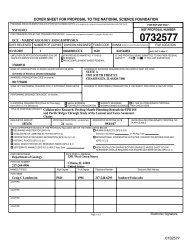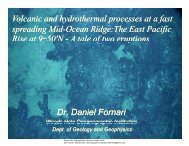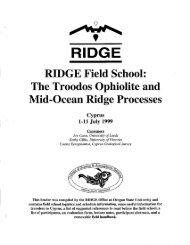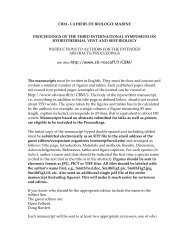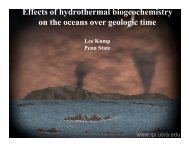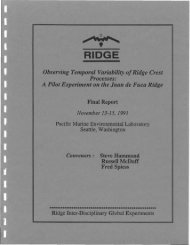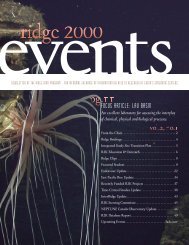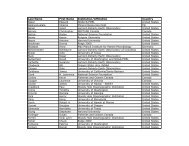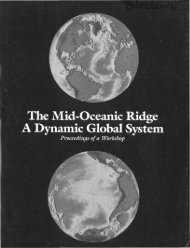NSF Forms - Ridge 2000 Program
NSF Forms - Ridge 2000 Program
NSF Forms - Ridge 2000 Program
Create successful ePaper yourself
Turn your PDF publications into a flip-book with our unique Google optimized e-Paper software.
lies on the far side of a ridge that separates it from the axis. If this sample proves to be young (~ 1 gram) visibly unaltered, fresh glass are indicated by<br />
special symbols in the data figures. As with all U-series disequilibrium studies ( 234 U/ 238 U) will be<br />
measured on each glass to ensure the absence of post-eruptive alteration or assimilation of altered<br />
crust. We plan to analyze six samples from the ABE bulls-eye region, two from each of the other<br />
hydrothermal sites, and thirty additional samples from the length of the ELSC and VFR,<br />
encompassing the entire range of chemical variation. That makes a total of 44 samples. All of these<br />
samples will be analyzed for 226 Ra, 230 Th, 232 Th, 238 U and 234 U. A subset of samples from the<br />
hydrothermal sites will also be analyzed for 210 Pb directly by gamma measurements and by alpha<br />
spectrometry using 210 Po as a proxy. These measurements are important as disequilibria will<br />
indicate that the samples are less than 100 years. We have several samples appropriate for such<br />
measurements. In addition, new samples from the Fisher cruise (see letter in Appendix) could<br />
contribute to our U-series studies. The Scripps resident technicians are experts in rock sampling,<br />
and will be providing the necessary on board assistance. We emphasize that we do not require these<br />
samples for the success of our proposed program, but we will certainly make use of them if they are<br />
obtained as planned.<br />
Our scientific aims require high precision measurements that are possible at only a handful of<br />
laboratories in the world. Dissolution and spiking of samples will follow the methods of [Sims et<br />
al., 2002; Standish, 2005], which together with chemical separation techniques [Goldstein et al.,<br />
1989; Layne and Sims, <strong>2000</strong>] will be completed at Harvard in Langmuir’s clean lab. Standish<br />
carried out U-series measurements as part of his thesis, and he will use the same methods and Sims’<br />
spikes to do the chemistry at Harvard. If we hear that the proposal will be funded, Standish will<br />
immediately begin the chemistry, and we anticipate the lab to be fully operational before the start<br />
date of the project.<br />
Because concentrations of U-series isotopes in volcanic rocks are very low, these measurements<br />
also require high sensitivity and high–abundance sensitivity mass spectrometers, capable of<br />
measuring as few as 10 8 atoms and isotopic ratios as small as 10 -6 . WHOI owns two mass<br />
spectrometers ideally suited for the measurement of U-series nuclides, as detailed in the facilities<br />
section, and such data from WHOI are already included in more than a dozen publications.<br />
7. RESPONSIBILITIES OF PERSONNEL AND WORK PLAN<br />
This work involves a multi-disciplinary approach, where diverse geochemical tools will be<br />
combined with geological constraints and interaction with those investigating hydrothermal systems<br />
and the biota. Our team for this proposal has the necessary background and expertise to efficiently<br />
carry out the proposed work. Langmuir was chief scientist on the sample collection cruise, and<br />
supervises the major element, trace element and isotope work on the samples, as well as their<br />
interpretation within the tectonic context based on the bathymetric and sidescan data [Martinez et al.<br />
2006)]. Sims has been responsible for the application of U-series data to problems of melt<br />
formation, volcanology and geology in the 9°N region. Standish completed U-series work with<br />
Sims at Woods Hole as part of his thesis, and is currently a post-doc in Langmuir’s lab at Harvard.<br />
Bezos, who has a minor role in this project, is the Research Associate scientist working on major<br />
D-13<br />
0649641




